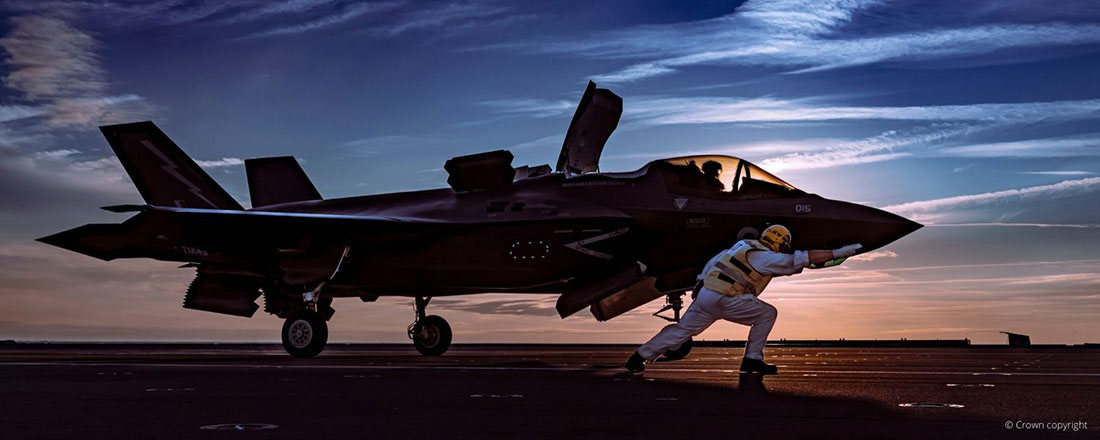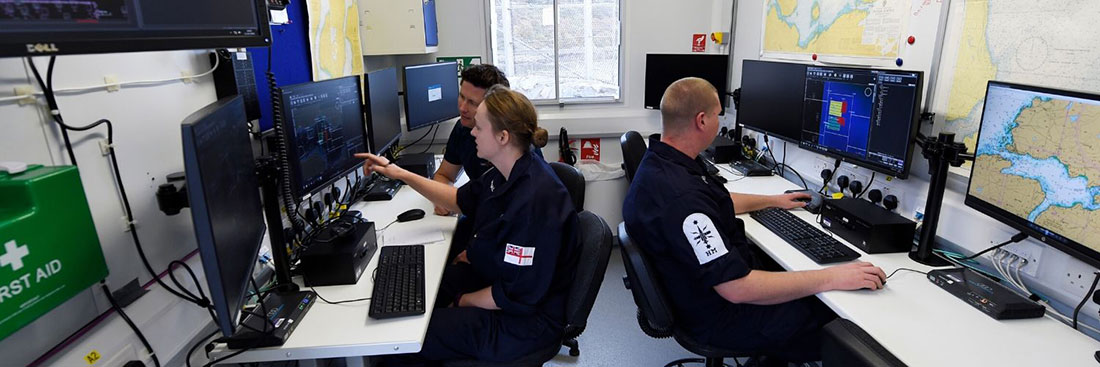Collaborative advantage: an opinion piece by Air Marshal Philip Osborn
01/07/2020
There has been a sea change over the last few years in the way that the military perceives information and data. I remember a period not so long ago when we thought an awful lot about hardware and platforms, and then considered information and data as supplementary elements. They were always the poor cousins of heavy metal. As a result, if you ended up with the right information, at best it was stove-piped, making it hard to get at and use. At worst, it was just a total fluke.
However, in the last few years the information environment, and the way nations and militaries need to husband and exploit their data has come to the fore. This has been driven partly by the threats from adversaries; partly by the awareness gained from past mistakes where we didn’t pay enough attention to data; and partly by seeing how information and data has influenced our personal lives. Information is now strategically important to Defence and has become recognised as key to military success. If we just take two really pivotal air platforms - the F35 and the P8 – both are nothing without the right Intelligence Mission Data. In effect, the right data is as essential as the right weapons...
So, where have we seen a shift in emphasis with the UK and Allies? There is now a much greater appreciation of data as a vital element of military power. The effectiveness of military capability, much of it (rightly) still hard power capabilities, is increasingly dependent on the quality of the data that is available. More strategically, there is much better understanding of how obtaining a rapid sense of your environment, and of adversary activity, enables faster and better decisions, as well as the option to take pre-emptive action if appropriate. There is also a growing appreciation that better exploitation of data offers more effective deception – a critical element of warfare that is somewhat under-discussed – as well as a much better chance of countering any adversaries deception tactics. Overall, during my military service, my core skill was how to fight in the air and latterly space... today, it is just as important to also know how to understand, husband, and then exploit data for military advantage.
The good news is that the conversation is moving in the right direction. No longer are we overly concerned with nomenclature, language and unified terminology. Defence forces around the world are now looking more intently at the steps they need to take to practically realise the potential of data to give them a true information advantage in operational environments.
There are several changes that will help achieve that ambition. They span the themes of people, technology and Processes, and I will address each individually in a moment.
But underpinning them all is the need for a much more fundamental shift – a change in the way Defence customers and industry partners deliver outcomes based on data. Partnerships are already an essential part of the Defence ecosystem. Militaries rely on their deep relationships with industry, and industry organisations need to partner with each other to deliver fully to their Defence customers. But the partnerships that are required to deliver information advantage are, I think, very different. The very nature of having to share deeply people, knowledge and risk, all essential for success, requires partnered relationships that are far stronger and trusting, and hence more robust and persistent. In essence, these are the relationships that are necessary when partners share an intertwined responsibility for each other, and everyone sees the perpetual nature of their collaboration as essential to the outcomes they all need to achieve. This is different to today and therefore requires a different way of working, tailored no doubt to individual partner cultures and strengths, but different all the same.
People
Turning to ‘People’, the first of our three themes, it is clear to everyone involved that the key element to any prospective solution is having the right personnel. Achieving an information advantage is an intellectual challenge and whilst the right people exist, there just aren’t enough of them in either defence forces or defence industry today. This is undoubtedly a shared problem, so there are shared solutions to be enacted and shared benefits to be drawn. The UK military is already heavily invested in the concept of ‘whole force’ – the ability to marshal all assets across government and industry to meet national strategic requirements. To my mind, there isn’t a better example of where the whole force approach could deliver significant good for both Government and industry than the challenge of information advantage.
The military have traditionally valued the talents of generalists. The challenge of information advantage needs specialists – especially now when we rely on people’s deep knowledge to fill gaps where technology is not yet capable enough. Both Government and industry have an equal requirement for personnel here. So we have a need to work together to attract, recruit, train and retain them and strategic partnerships are necessary to address this in a unified, mutually beneficial way. For example, if both parties can collaborate to offer broader, more flexible career paths where people can step in and out of roles in government and industry equally, we will all find it easier to attract and keep the right talent to support our collective objectives around information advantage. Managing people and skillsets is probably the most important element of the Defence information and data challenge, and it is something that can only be solved together.
Technology
Our second theme is Technology, and the overwhelming importance of people in the information advantage equation does not in any way reduce the significance of technology. In fact, we are already seeing technology starting to take over the burden of many data-centric tasks that we have traditionally used clever people to do. But the importance of technology is much wider than the undoubted improvements that human/machine teaming will bring to the design and production of information capabilities.
Information and data may be the currency of modern warfare but, to a large extent, it is the emergence of more sophisticated platforms that have driven this. A few years ago, you could get airborne in a fast jet, drop a bomb, and then return and land, all without any data. You simply cannot do that today and even more so in the future. Moreover, even getting airborne with poor or incomplete data means that you will do a poor or incomplete job ... and hence lose. And this is true in the air, it also applies to the other environments. Information, good information, is now such an intrinsic element of warfare that it is both an input and an output, and hence Defence is shifting from a platform-centric approach to a data-centric approach. This is opening up new opportunities to obtain and then exploit information advantage. But these opportunities can only be realised if military capability is designed to prioritise information advantage at the outset, or there is focussed effort to enhance legacy capabilities and processes to incorporate information advantage. And, to do this, there are probably three considerations.
Firstly, the environment needs to foster technology innovation because obtaining new information and using it for benefit relies on novel thinking. Defence customers need to demand more innovative ideas from their industry partners. But industry equally needs to push Defence to be willing to experiment more, take greater (yet calculated) risks, and consider unorthodox ideas as part of the journey. This is how both parties will succeed together. There are a plethora of examples of this type of innovation in the information space already but very few today in defence.
In large part, this lack of innovation stems from the way partnerships in Defence are often bound into ‘adversarial’ contracts, which promote detailed commercial requirements above strategic outcomes. So, secondly, the procurement environment needs to encourage a more strategic approach to this shared challenge that matches the speed at which the information space moves. Technology requirements need to be identified at a higher level, and agreements should be based on delivering outcomes, not technical specifications. As well as engendering deeper trust and a more closely bound relationship, it will allow for greater flexibility and agility, which is so vital given the pace of technology change, and the consequent and quickly increasing challenge of adversary capability.
Finally, the promotion of technology interoperability needs to be second nature. Militaries are historically not bad at this. For example, NATO provides the only framework in the world within which you can operate true coalition warfare. But we must collectively do better, as the pace of technological and information change brings with it an increasing risk of losing interoperability. And this is where a closer, mutually beneficial relationship with industry can provide advantage. Take Intelligence Mission Data (the fusion of multiple data sources to create coherent actionable intelligence) as an example. The need for Intelligence Mission Data in now recognised as fundamental to the effectiveness of current and new capabilities, capabilities that are used by many similar nations. We in industry should be able to spot the Intelligence Mission Data interoperability opportunities that exist, and where greater advantage for all can therefore be achieved as a result. This might lead to the use of emerging technologies more quickly, or more effective relationships between Government and Governments, and industry. It may also drive policy changes to promote interoperability from the bottom-up. For example, we have already seen the start of this in the UK with a consorted Government/industry effort to establish a common Electromagnetic Activities Policy for the benefit of our collective needs. Industry however can go much further, taking on the responsibility of building the right partnerships and relationships with businesses that have developed new interoperable technologies for information advantage but do not have the connections or clout to deliver these great solutions to Government customers. One can see the benefit of building communities of SMEs that can exploit larger companies’ existing strategic partnerships with Governments as a faster way to get important technology into the hands of Defence users. This would ensure that customers have access to novel technologies for information advantage quickly and are able to adopt them knowing they are already assured of successful interoperability. Once again, both parties gain mutual benefit in meeting a shared challenge in the race to use data for information advantage.
Process
To make this all possible, militaries around the world need to be open to changes in the processes they use for everything from procurement to implementation. This is predominantly about tackling some of the issues already outlined by building new methodologies that are shared, enduring, and based on mutual trust. From a people perspective, this means collaborating on new ways of attracting, recruiting and training people to get the right qualified and experienced people for information advantage; from a technology perspective it is about undertaking digital transformation together, rather than incremental technical adaption in silo, and working interoperability into the heart of capability development.
Fundamentally, we are all clear that no single organisation has all the answers so there is a need to find better ways to ally, not just between Government and industry, but also Government to Government, and industry to industry. This obvious presents a challenges as well as opportunities, as national defence forces should balance their sovereign need for world-leading intelligence with the need to support national prosperity agendas. Put simply, getting ahead of this will be pivotal for UK prosperity as well as for UK military capability.
The power of partnership for information advantage
This is a global challenge. The need to work across borders – be they geographic, political, commercial, or indeed conceptual – is essential. Every nation will have its own ambitions around the information space but the changes required to people, technology and process are universal. These three tenets of change are also not mutually exclusive - information advantage is only achievable when there is success in all three. If you see this as a Venn Diagram, it is only at the centre that Defence and industry both win. This is why the imperative is to build a new type of strategic partnership between Defence and industry. Our collective focus has to be on securing success for all, and not just focusing on ‘what’s in it for me?’.
In sum, information advantage is the ultimate shared opportunity and challenge for the Defence ecosystem today.
About the author: Air Marshal Philip Osborn, CBE, FRAeS, RAF (retd) is a Non-Executive Director at Inzpire Ltd (part of the QinetiQ Group) and former UK Chief of Defence Intelligence (2015-2019).






